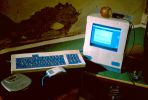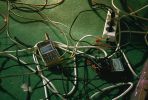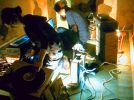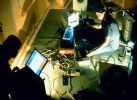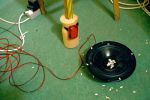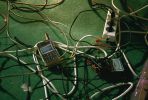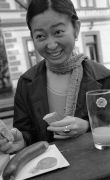Technology and machines mold human bodies and our movements as much as we have a hand in molding them. From craning your wrists to tap onto keyboards, to inserting your body into a carseat, bodies become as much conjoined and synthesized with machines as they utilise them. Human voices become processed as they speed through telephone wires and digital computer fonts become our means of standard communication.
In attempting to communicate with other humans via telephones, sending email and faxes, live web links, radio transmissions and playback of recorded sound, we learn to read our machines' bleeps and flickers of light as communication signals as well, as they tell us of low battery power, errors in their systems, and their general state of well-being. This form of communication commands us to learn their language and patterns as much as we have created theirs.
A small compact room within the monastery was fitted with a green carpet hedged by a painted white perimeter line, and a chaotic scattering of machinery and technology littered the floor. The installation reclaimed and recycled pieces of outmoded machinery--finding a new functionality, they were transformed with a new visual and audible aesthetic--a Macintosh II finds itself masquerading as an iMac--perhaps a new object of desire; a malfunctioning reel-to-reel tape player is switched on purely for the purring sound of its semi-working mechanism. These were combined with high-end contemporary gadgets: talking powerbooks, beeping pagers and cushioned CD players. "Hand-made" and non-functional machine components (e.g. placebo mobile phones made of foam) immitated and integrated themselves with the "real" machines.
In the isolation of the Centre for Metamedia in Plasy, the community of artists relied upon technological agents to connect and communicate with their outside lives and some displayed a further reliance in their work on a variety of modern technology (powerbooks, video projectors and so forth). In contrast to this, the CMM itself was littered with out-moded technologies of communication. "I Love Technology and Technology Loves Me," a collaborative installation/performance by Gail Pickering and Stephanie Syjuco and borne directly out of the environment of the CMM, seeks to explore this modern (co-)dependency between humans and technology--for communication and social status, the post-functionality of redundant technologies, and the new language structures emerging from the communication processes.
The superiority of the eye in contemporary culture bypasses a consideration for the sounds of our daily lives, with universal languages taken for granted. Passing through cables and across airwaves, the sounds of connection and contact are generally isolated to the lone user. "I Love Technology..." harnessed these sounds, made them multiples and musical scores: pre-recordings, live recording and playback, re-recording, live microphone pickup--all were amplified and orchestrated into tidal waves of the chaotic noise of a communicating world, a cacophonic symphony of machine-voices seeking their listeners.
The performance was transmitted live on air-band to the immediate outside vicinity of the monastery--a police car stopped and stayed awhile, perhaps confused at what its radio tuner was receiving and then drove on.
Collaborative installation/performance sessions using modified found electronic equipment.
Mixed media includes:
- 1 visually refurbished Macintosh II
- 2 reel-to-reel tape players
- 1 slide projector
- 2 Macintosh G3 Powerbooks
- 1 broken record player
- 2 amps
- 1 CD player
- 2 minidisc players
- 1 radio transmitter
- 2 Marantz tape players/recorders
- 1 hand-held cassette player/recorder
- 3 sets of speakers
- 1 mixer
- 2 microphone/amps
- 1 pager
- 1 mobile phone
- 1 digital watch
- 2 LED bicycle lights
Tailored furniture and lighting design included:
- found wood-laminate shelving,
- plastic bags,
- multi-colored electrical tape,
- packing tape,
- green carpet recycled from a Martin Kippenberger installation
Pickering+Syjuco
Stephanie Syjuco creates large-scale spectacles of collected cultural objects, cumulative archives, and temporary vending installations, often with an active public component that invites viewers to directly participate as producers or distributors. Using critical wit and collaborative co-creation, her projects leverage open-source systems, shareware logic, and flows of capital, in order to investigate issues of economies and empire. This has included starting a global collaborative project with crochet crafters to counterfeit high-end consumer goods, presenting parasitic art counterfeiting events, and developing alternative vending economies. She is featured in Season 9 of the acclaimed PBS documentary series Art21: Art in the Twenty-First Century. Recent exhibitions include "Being: New Photography" at the Museum of Modern Art, New York, "Public Knowledge," at the San Francisco Museum of Modern Art, and "This Site is Under Revolution" at the Moscow Museum of Modern Art. She will be featured in "Disrupting Craft: the 2018 Renwick Invitational" at the Smithsonian Museum of American Art, opening November 2018.
Born in the Philippines in 1974, Syjuco received her MFA from Stanford University and BFA from the San Francisco Art Institute. She is the recipient of a 2014 Guggenheim Fellowship Award and a 2009 Joan Mitchell Painters and Sculptors Award. Her work has been exhibited widely, including at MoMA/P.S.1, the Whitney Museum of American Art, The San Francisco Museum of Modern Art, ZKM Center for Art and Technology, the California Biennial at the Orange County Museum of Art, The 12th Havana Bienal, The 2015 Asian Art Biennial (Taiwan), among others. A long-time educator, she has taught at Stanford University, The California College of the Arts, The San Francisco Art Institute, Carnegie Mellon University, and is an Assistant Professor in Sculpture at the University of California at Berkeley. She lives in Oakland, California.
